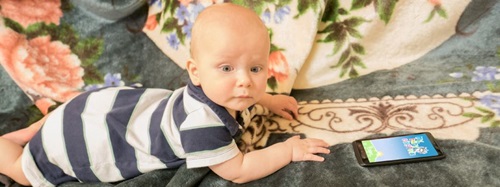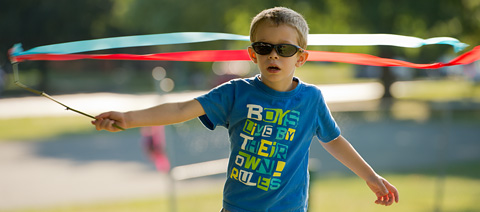Infants, Toddlers, and Screen Media
| May 2016In a technology-driven age, infants’ and toddlers’ exposure to “screen time” is a hot topic. As caregivers in the classroom, we may be pressured by parents who use screen media with their children at home—parents who would like us to help their children acquire technology skills they will need to use later on. But we know that not all screen media are healthy for children and that exposing very young children to screen media can have lasting impacts on their learning. In fact, the effects of media on children’s learning and behavior is so profound that the American Academy of Pediatrics (AAP) states that no child under the age of two should be exposed to screen media, and that screen time for children over two years should be limited to no more than two hours per day (AAPS 2010). In this article we will view screen time through the lens of infants’ and toddlers’ development to help us make intentional decisions about what is best for children, and to assist in giving parents a healthy alternative to screen media.
Definitions
First, we need to define what “screen time” or “screen media” is and discuss the status of screen media with regard to infants and toddlers in our society. The definition of screen time or media time is any period of time spent viewing or using TV/video, video games, computers, handheld video game players, cell phones, smartphones, iPods/iPads/androids, or any other digital tablet device. Most parents, early educators, and health providers agree that screen media can have a profound effect on children’s learning and development, whether it be positive or negative. A recent report from Common Sense Media titled “Zero to Eight — Children’s Media Use in America 2013” states, “The only way to maximize the positive impact of media on children is to have an accurate understanding of the role it plays in their lives: which platforms they are using, the activities or content they are engaging with on those platforms, and how their media use patterns vary by age, gender, or socioeconomic status” (Rideout, 2013).
A Picture of Media Use
So what does screen media use look like for an infant or a toddler? Below are some findings based on research conducted by Common Sense Media specifically for this age group.
- Children under the age of two spend an average of 58 minutes per day with screen media. Forty-four minutes of that time is spent watching television.
- Children aged two to four spend an average of one hour and 58 minutes per day with screen media. One hour and four minutes of that time is spent watching television.
- Sixteen percent of children under the age of two, and 37 percent of children aged two to four have a television in their bedroom.
- Forty percent of children aged birth to one year, and 76 percent of children aged two to four years watch “educational shows,” described as “Sesame Street,” “Mythbusters,” and the like.
- Devices for playing games are the most commonly used types of mobile media (63 percent).
- Parents of children aged birth to eight say they use media to occupy their children when they are running errands together (23 percent, often; 80 percent, sometimes) and doing chores at home (13 percent, often; 42 percent, sometimes). (Rideout, 2013)
Interpreting the Research
So what do these findings mean in terms of infant and toddler development and what we should be doing with infants and toddlers in our programs? More and more studies are showing that excessive media use can lead to attention problems, difficulties in school, sleeping and eating disorders, and obesity. As seen in the above findings, children at younger and younger ages are not only exposed to media but are using media for longer periods of time. According to Boston University Medical Center, media “could interfere with the development of empathy, social, and problem-solving skills that are typically obtained by exploring, unstructured play and interacting with peers” (Boston University Medical Center, January 2015).
Young children need to be actively engaged with their learning, through both mind and body. Children who sit in front of screens watching TV/DVDs, or listening to a book read on the computer, are engaging in a very passive way of learning. Research has shown that children under the age of 30 months do not learn from these types of experiences (Boston University Medical Center, January 2015). Also, excessive sedentary and passive screen time is associated with negative consequences for children’s development. Language is one such area of development, and since infants and toddlers are laying the foundation for language learning, this is extremely important to note.
As shown in the statistics given above, television is still the dominant use of screen media, and there has been an increase in ways young children can access TV shows through mobile devices — which makes them easier to view anywhere and at any time, including in bedrooms. We even see children coming into or leaving our programs watching something on their parent’s iPhone. It is also important to note that, when adults use media to distract children or manage their behaviors, children don’t learn to internally self-regulate or develop the social and emotional skills needed to interact appropriately with others (Boston University Medical Center, January 2015).
The Importance of Active Learning
Jean Piaget defines infants and toddlers as sensory-motor learners—meaning they learn about their world through their senses and with their whole bodies. They need interactions with objects to learn what they feel like, how they smell, how they taste, what they sound like, and how they can be used. It is for this reason that an active participatory learning model is so helpful for their growth and development. Active participatory learning is defined as “the direct and immediate experiencing of objects, people, ideas, and events—a necessary condition for cognitive restructuring and hence for development” (Epstein and Hohmann, 2012).
The Five Ingredients of Active Learning
To ensure an environment that builds trust, autonomy, and initiative and where active learning can flourish, caregivers provide the five ingredients of active learning:
1. Materials: There are abundant, age-appropriate materials the child can use in a variety of ways. Learning grows directly out of the child’s direct actions on the materials.
2. Manipulation: The child has opportunities to explore (with all the senses), manipulate, combine, and transform the chosen materials.
3. Choice: The child chooses what to do. Since learning results from the child’s attempts to pursue personal interests and goals, the opportunity to choose activities and materials is essential.
4. Child communication, language, and thought: The child communicates his or her needs, feelings, discoveries, and ideas through motions, gestures, facial expressions, sounds, sign language, and words.Adults value, attend to, and encourage the child’s communications and language in a give-and-take manner.
5. Adult scaffolding: Adults establish and maintain trusting relationships with each child in their care. Adults recognize and encourage each child’s intentions, actions, interactions, communications, explorations, problem solving, and creativity.
Infants’ and toddlers’ learning grows out of their direct actions on materials, people, and events in their environment. As active learners, these very young children need to be able to stretch, reach, grasp, hold, mouth, bang, roll, sit, crawl, pull, walk, climb, carry, and so on. They need to engage in a three-dimensional investigation of their world to build true understanding of the functions and properties of materials and to build trusting relationships with the people who care for them.
It is through a multitude of experiences with real objects and real people that children build connections in their brain and strengthen those connections to make them automatic. Infants’ and toddlers’ brains are wired for learning, and the brain grows according to the ways in which it is nurtured.As children interact and experience their world, they are developing the necessary neural connections in their brains for continued learning. With each repetition of an action, they are strengthening these neural connections, and thus laying the foundation for all future learning. If infants’ and toddlers’ explorations and experiences involve screen media, then their brains are literally being “wired” to learn in a different way. For example, an infant sitting in front of an iPad and randomly hitting the screen of a two-dimensional keyboard as it makes a sound (prompting the infant to repeat its actions) will not have the same connections in her brain as an infant who bangs on a real piano while being held by a caregiver. However adorable it is, an infant’s play with an iPad produces different sounds, different images, and different experiences, and the child is not using all of her body and senses to engage in the experience; she therefore is not having as rich a learning experience as she could with other materials — meaning that her brain is not developing the way it is naturally intended to.
In addition, for optimal learning to occur, all the ingredients of active learning need to be present; including the vital ingredient adult scaffolding. We scaffold children’s learning when we support them at their current developmental level and provide gentle extensions to their play and exploration as the child seems ready. Screen media promote the opposite of this kind of learning because they take out the two-way interaction. For infants and toddlers to be able to venture out into their world to explore and investigate, they need a secure attachment with a trusted, responsive caregiver who will be there as a safe base. Nurturing relationships underlie all learning at this age.
In summary, infants and toddlers learn best when they are actively engaged with real objects and people instead of using screen media. There is no evidence that if children are exposed to screen media at a young age they will become more advanced in their learning of technology. However, there is clear evidence that early exposure to screen media can have long-term negative effects on children’s learning. Just as we know children will grow up and learn to ride a bike or drive car, we also know they will learn how to use screen media and do so quite easily when their brains are developmentally ready and primed to learn in this way. As caregivers and parents of infants and toddlers, we can provide alternatives to screen media that will be more beneficial for the children’s learning.
References
American Academy of Pediatrics (AAP). (2010, November). Media education (policy statement.). Pediatrics, 126(5). www.pediatrics.org/cgi/doi/10.1542/peds.2010-1636
Boston University Medical Center. (2015, January 30). Mobile and interactive media use by young children: The good, the bad, and the unknown. ScienceDaily. Retrieved from www.sciencedaily.com/releases/2015/01/150130102616.htm
Epstein, A., & Hohmann, M. (2012). The HighScope Preschool Curriculum, p. 17. Ypsilanti, MI: HighScope Press.
Rideout, V. (2013, October 28). Zero to eight: Children’s media use in America 2013. (Research study by Common Sense Media). Retrieved from https://www.commonsensemedia.org/zero-to-eight-childrens-media-use-in-2013
Adapted from Infants, Toddlers, and Screen Media, HighScope Extensions newsletter, Vol. 29, No. 4, Ypsilanti, MI: HighScope Press. Retrieved from www.highscope.org. ©2014, HighScope Educational Research Foundation. Used with permission.







